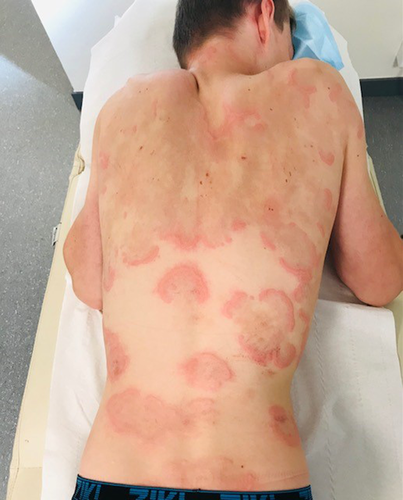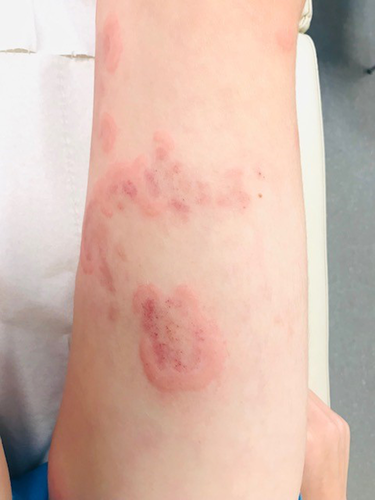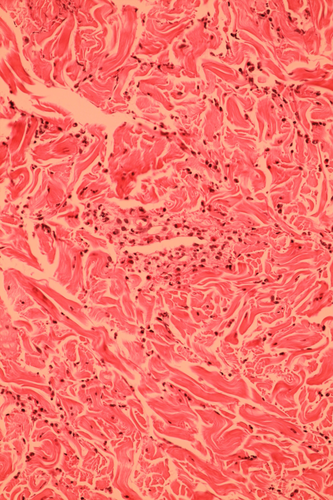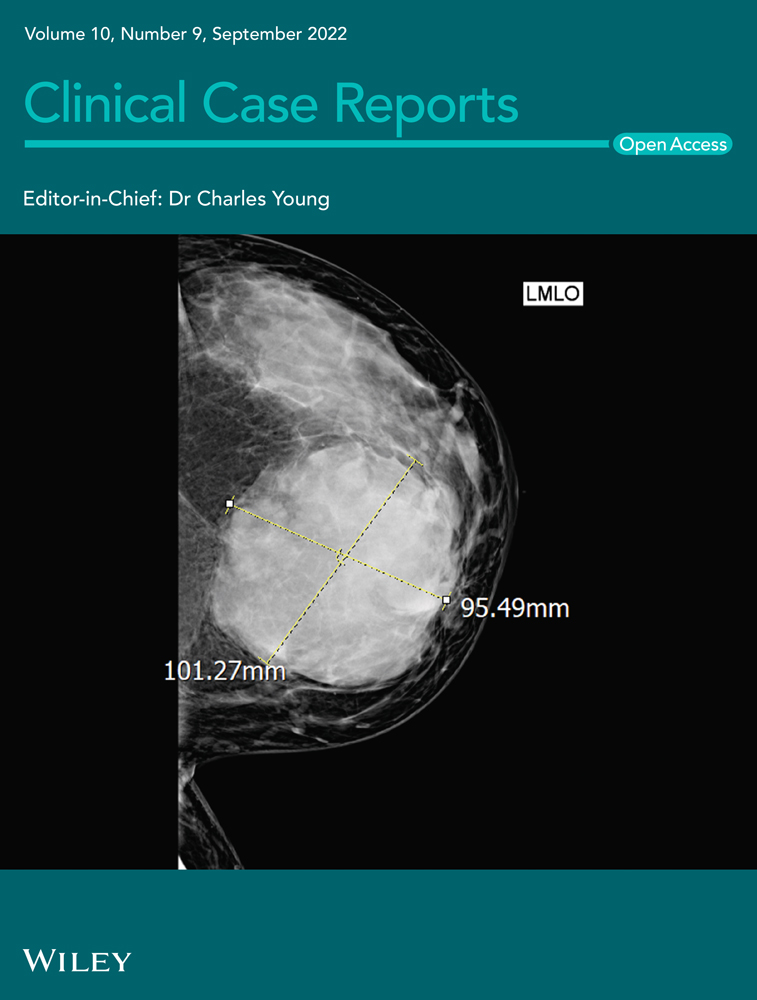Urticaria multiforme in an adolescent: A rare benign rash not to be ignored
Abstract
Urticaria multiforme, first described in 1997, also called acute ring urticaria, is a clinical variant of acute urticaria. We relate the case of a 16-year-old adolescent with an extensive pruritic eruption of erythematous annular lesions of variable shapes, arciform, or polycyclic with an ecchymotic center. Urticaria multiforme is described in children aged from 4 months to 4 years, rarely in adolescents. As far as we know, this is the 4th case reported in the literature.
1 INTRODUCTION
Urticaria multiforme, first described in 1997, also known as acute annular urticaria, is a clinical variant of acute urticaria, which mainly affects children aged from 4 months to 4 years and presents as an extensive pruritic eruption of annular, arciform, or polycyclic erythematous lesions including an ecchymotic center.1 The most common triggers are infections, medications, and vaccinations. The rash usually resolves spontaneously in 8–10 days and responds favorably to treatment with antihistamines.2 The differential diagnosis is erythema multiforme, acute hemorrhagic edema of infants, or pseudo-serum sickness.
2 CASE REPORT
A 16-year-old adolescent presented an extensive, pruritic rash that appeared abruptly 1 week ago in the form of annular, arciform, sometimes polycystic erythematous lesions with an edematous peripheral border and a pale center. Often ecchymotic, the lesions are located on the trunk, limbs, and face with palmoplantar sparing (Figure 1 and 2). The lesions are labile and do not persist for more than 24 h. A form of Dermographism is associated. The extremities are not edematous. There is no ulceration of the oral or genital mucosa, nor are there any target lesions. The throat is mildly erythematous. The patient is in good general condition. He reported a cough and rhinorrhoea for about 10 days.


He had no previous medical history and no known allergies. He had not taken any medication. He has not had any vaccinations recently.
The biology shows a moderate inflammatory syndrome (CRP 50 mg/L; normal range <5 mg/L) with a normal leucocyte count. Viral serology (EBV, CMV, parvovirus, hepatitis) is negative as well as the anti-nuclear factor. A PCR test for SARS-CoV-2 was also negative. Histology showed edema of the dermis with an eosinophilic infiltrate (Figure 2). There was no bullous detachment, and immunofluorescence was negative.
Therapeutically, treatment with an antihistamine (Bilastine 20 mg) was initiated with a favorable evolution and complete resolution of the rash in 14 days (Figure 3).

3 DISCUSSION
Urticaria multiforme, also known as acute ring urticaria, mainly affects young children, aged from 4 months to 4 years. As far as we know, only 3 other cases involving adolescents aged 17 and 18 years have been reported in the literature.2-4 The most recent case is an 18-year-old girl with a COVID-19 infection simultaneously with the rash.3 Urticaria multiforme is often associated with an infectious episode, as it was the case with our patient, or following vaccination or medication.5 Histology shows a localized edema in the dermis with a perivascular and interstitial infiltrate rich in eosinophils and neutrophils with some histiocytic cells, compatible with the diagnosis of urticaria multiforme.6 Discrete vascular changes may also be seen without strong fibroid necrosis. This histologic appearance is similar to that of leukocytoclastic vasculitis. However, the pruritic and migratory nature of the lesions, as well as the presence of dermographism and the absence of residual pigmentation, are clinical criteria in favor of urticaria multiforme.7 There are no known complication. Abstention from treatment is possible due to the often spontaneous resolution of the rash within 10 days. However, treatment with antihistamines or systemic corticosteroids may be considered in the most severe cases.2
4 CONCLUSION
Urticaria multiforme mainly affects young children, aged from 4 months to 4 years. This clinical variant is rarely encountered in adolescents, but it should be considered. This clinical entity is too often ignored by practitioners, which leads to unnecessary investigations such as biopsy or blood test. The diagnosis can be made on the basis of the history and clinical examination.
AUTHOR CONTRIBUTIONS
The content of the paper intituled “Urticaria multiforme in an adolescent: A rare benign rash not to be ignored” Manon Dupont MD, Anne Theunis MD, Olivier Vanhooteghem MD, have contributed significantly, and are in agreement with the content of the manuscript. In keeping with the latest guidelines of the International Committee of Medical Journal Editors, each author's contribution to the paper is to be quantified.
ACKNOWLEDGMENTS
None.
CONFLICT OF INTEREST
NA.
CONSENT
Written informed consent was obtained from the patient to publish this report in accordance with the journal's patient consent policy.
Open Research
DATA AVAILABILITY STATEMENT
Data availability on request.




